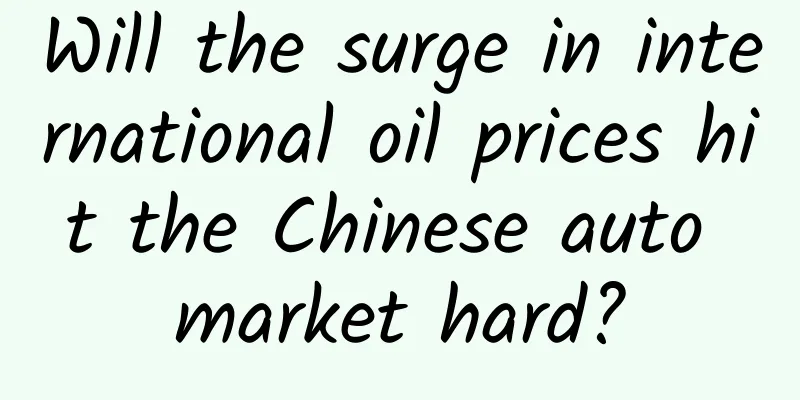Will the surge in international oil prices hit the Chinese auto market hard?

|
When filling up a tank of gas costs more than 20 yuan, or even more, the very sensitive Chinese people have to consider their own wallets. Will the car manufacturers, who have been so happy for a year, be "blue and thin" because of this? If the oil price rises sharply and quickly, what impact will it have on the Chinese auto market? While the Chinese auto market was still debating whether to continue the policy of halving the purchase tax for small-displacement cars with a displacement of 1.6L or less, or whether to reduce the preferential rate, on November 30, the Organization of Petroleum Exporting Countries (OPEC) announced that it had decided to reduce its daily crude oil production by 1.2 million barrels and set the daily crude oil production limit at 32.5 million barrels. The production reduction decision will take effect on January 1, 2017. This decision, which took seven hours to make at the OPEC headquarters in Vienna, the capital of Austria, may have an impact on the other side of the Eurasian continent like the flapping of a butterfly's wings. Not only that, OPEC will also hold a meeting with 14 non-OPEC oil-producing countries to expand the scope of production cuts. Influenced by this incident, international oil prices have risen by more than double digits in recent days, which means that China's oil prices may bid farewell to the "red line" of no price reduction below $40, and sound the horn of upward rebound. What impact will this have on the Chinese auto market, auto and related listed companies? Will the major auto companies be too busy expanding production capacity for nothing and create risks? First, it may create adverse factors for the continued growth of the automobile market and inhibit automobile consumption. Unlike the endogenous consumption in the high-growth period in the past, the volume of the new car sales market has now reached a relatively high level, entering a period of slow growth and what people call the "new normal." On the other hand, as more and more cities are facing traffic jams, parking difficulties, restrictions on driving and purchases, and other unfavorable factors that affect car use, more and more people are starting to choose public transportation, Internet ride-hailing, and even the recently popular shared bicycles. The increase in costs brought about by rising oil prices may become an important factor in suppressing car consumption. According to the Economic Information Daily, on December 14, domestic oil prices will rise for two consecutive days, which may set a new record for the highest increase in 2016. By then, the cost of filling up a tank of oil for a private car will increase by about 21 yuan. Next year, oil prices may continue to rise after production cuts, and uncertain unfavorable factors will become potential risks in the auto market. In fact, at the 2016 China Automobile Dealers Association Annual Conference, nearly a thousand dealer group leaders, OEM executives and industry professionals attending the conference expressed concerns about the withdrawal of the small-displacement stimulus policy. More than 60% of them believed that if the policy was withdrawn, the growth rate of the auto market in 2017 would be less than 5%, so rising oil prices might make the situation worse. Secondly, rising oil prices may affect the stimulus policy for small-displacement vehicles and reverse the "embarrassment" of new energy being driven solely by policies. Fuel-efficient hybrid vehicles may also gain greater space. Recently, the media reported that an association suggested that relevant departments continue the preferential policies for small-displacement cars to ensure the continued growth of overall car sales. However, if the oil price rises significantly, the "invisible hand" of the market may automatically adjust to allow consumers to choose low-fuel-consumption energy-saving cars, and even make consumers tend to choose new energy vehicles. In fact, from 3-4 yuan per liter ten years ago to more than 8 yuan per liter three years ago, and then to more than 5 yuan per liter now; from "93 plus 200", filling up most car tanks, to at least 300 yuan to fill a tank of gas, although Chinese consumers are accustomed to price fluctuations. However, many survey results show that oil prices have become one of the three most important factors for most consumers when buying a car, especially in third-tier and lower cities, where oil prices are usually as important as appearance. Therefore, the increase in oil prices is a double-edged sword. It may suppress consumption, but it can also be used to change consumers through economic means to choose energy-saving and environmentally friendly vehicles or travel methods. The "top-level design" needs to make a choice. On the other hand, Auto K-line believes that if oil prices rise too quickly and stimulate consumers' sensitive nerves, as localization costs gradually decrease, the hybrid vehicle market in China, which has been dormant for nearly a decade, may usher in an explosion. At present, in addition to Toyota's launch of affordable hybrid electric vehicles (HEV) in China in recent years, Honda Motor also introduced this technology in 2016. What is more noteworthy is that the hybrid electric vehicles developed by Chinese brands such as Geely Automobile and Changan Automobile in cooperation with Corun will also be launched soon. During this year's "Two Sessions", Corun Chairman Zhong Faping drove the Geely Emgrand HEV with a fuel consumption of only 4.9L per 100km from Hunan to Beijing to attend the sessions. Auto K-line believes that nothing can stimulate consumers to accept hybrid vehicles more than soaring oil prices. Third, automobile manufacturers may face challenges from overcapacity, which poses risks. As we all know, due to the stimulus policies in 2015, the sales growth rate of China's new passenger car market returned to a "large" double-digit growth rate in 2016. Except for a few companies that had problems and sales declined, the vast majority of car companies achieved growth of more than 20%, or even nearly doubled. For example, Volkswagen, which had almost zero sales growth last year, Hyundai and Kia, which had negative sales growth, and Ford and GM, whose sales slowed down significantly, all showed growth this year. Chinese brands that made great strides last year, such as Geely Auto and GAC Group's Trumpchi, have seen growth of more than 40% this year. However, this has caused many auto companies to "get carried away" and blindly embark on the road of expanding production capacity again. It seems that the Chinese auto market can still expand indefinitely, and everyone thinks that they will not be the first to fall. Honda, Hyundai, GM and Volkswagen have already or plan to increase production capacity in China, and a new round of capacity expansion has arrived. For example, Honda recently built its third plant in Wuhan, with an investment of about 3 billion yuan, and aims to start production in the first half of 2019. In the fall of 2015, Honda suspended its new plant construction plan due to China's economic slowdown, but it believes that the investment environment has gradually become available in the past year and has decided to implement large-scale investment instead. The China Automobile Dealers Association and automobile experts have warned that production capacity must be reasonably controlled and correct expectations for the automobile market must not be allowed to continue until overcapacity results in large inventories that endanger the healthy development of dealers and the automobile market. As mentioned earlier, if oil prices rise rapidly and sharply, it will pour cold water on some automakers that are confidently expanding production. However, in addition to the wings of crude oil production cuts flapping on one side of the Eurasian continent, US President-elect Trump on the other side of the Pacific Ocean has also previously revealed that he may increase US crude oil production. So, can the tsunami caused by these two vibrating wings be offset? I still remember that the Chinese auto market had experienced a severe situation before. The new car market experienced a decline in demand after the global economic crisis, but it was supported by the tax cuts on small cars and the plunge in oil prices from 2009 to 2010, which increased demand and sales. However, due to the reverse effect of the high oil price recovery and the withdrawal of policies, the auto market stagnated again from 2011 to 2012. However, at that time, China's economy maintained a relatively high growth rate, which provided support for the auto market, but now the macro-economy is sluggish and the Chinese auto market lacks such strength. Auto companies need to prepare for a rainy day. As a winner of Toutiao's Qingyun Plan and Baijiahao's Bai+ Plan, the 2019 Baidu Digital Author of the Year, the Baijiahao's Most Popular Author in the Technology Field, the 2019 Sogou Technology and Culture Author, and the 2021 Baijiahao Quarterly Influential Creator, he has won many awards, including the 2013 Sohu Best Industry Media Person, the 2015 China New Media Entrepreneurship Competition Beijing Third Place, the 2015 Guangmang Experience Award, the 2015 China New Media Entrepreneurship Competition Finals Third Place, and the 2018 Baidu Dynamic Annual Powerful Celebrity. |
<<: Using people as a mirror: Why does LeTV say it is the most suitable company to build cars?
>>: FF mass-produced cars to save LeEco from car crisis: money is the most critical issue
Recommend
OpenAI & MIT: Research shows that frequent ChatGPT users feel more lonely
Two studies conducted by OpenAI and MIT Media Lab...
Are you using the 6 types of keywords that you must promote when doing marketing?
There are 6 common types of keywords : brand word...
Three amazing technical experts I met during my programming career
I have been programming for more than ten years w...
Yunman Shengcai Utopia Xiaohongshu and Douyin tutorials
From Yunman’s money-making utopia, there are mult...
High imitation Baidu Nuomi
Source code introduction: High imitation of Baidu...
Yiche.com: In June 2024, the Wenjie M9 won the first place in weekly sales of domestic cars with more than 400,000 units, twice as much as Ideal L9
Recently, Yiche.com released a weekly sales ranki...
Is your iPhone lagging more and more? Turn off these 3 default settings and your phone will run smoother
1. Turn off automatic system updates [[398263]] S...
Chinese car companies are entering the heart of Europe. The German Chancellor encourages car companies: Don't be scared
Recently, the International Automotive and Smart ...
2022 National Regulations on Rent Reductions Due to the Epidemic: Some businesses in medium and high-risk areas will be exempted from half a year’s rent!
Recently, affected by the epidemic, merchants in s...
Asian winter will make "ice and snow" more popular! Collect this guide and go hiking in the snow →
Opening remarks: The whole nation is going to the...
3 aspects to analyze the art of channel operation
In the Internet environment, it is said that traf...
The truth behind the "prosperity" of apps is sad!
Which excavator manufacturer is the best? Go to L...
User operation system for tens of millions of products!
Before we start discussing topics related to &quo...
Can a Baidu promotion port account add a framework account as a sub-account?
Framework users need to sign a contract between t...









